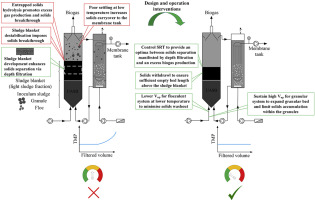当前位置:
X-MOL 学术
›
Water Res.
›
论文详情
Our official English website, www.x-mol.net, welcomes your
feedback! (Note: you will need to create a separate account there.)
Establishing the mechanisms underpinning solids breakthrough in UASB configured anaerobic membrane bioreactors to mitigate fouling.
Water Research ( IF 11.4 ) Pub Date : 2020-03-26 , DOI: 10.1016/j.watres.2020.115754 K M Wang 1 , A Soares 2 , B Jefferson 2 , H Y Wang 3 , L J Zhang 4 , S F Jiang 4 , E J McAdam 2
Water Research ( IF 11.4 ) Pub Date : 2020-03-26 , DOI: 10.1016/j.watres.2020.115754 K M Wang 1 , A Soares 2 , B Jefferson 2 , H Y Wang 3 , L J Zhang 4 , S F Jiang 4 , E J McAdam 2
Affiliation

|
In this study, the mechanisms for solids breakthrough in upflow anaerobic sludge blanket (UASB) configured anaerobic membrane bioreactors (AnMBRs) have been described to establish design parameters to limit membrane fouling. As the sludge blanket develops, two periods can be identified: (i) an initial progressive enhancement in solids separation provided through sludge blanket clarification, via depth filtration, which sustains downstream membrane permeability; and (ii) sludge blanket destabilisation, which imposed solids breakthrough resulting in a loss in membrane permeability. The onset of sludge blanket destabilisation was identified earlier in the flocculent AnMBR, which was ascribed to an increased gas production, caused by hydrolysis within the sludge blanket at extended solids residence time. Whilst hydrolysis also induced higher gas productivity within the granular AnMBR, solids breakthrough was not evidently observed during this period, and was instead only observed as the sludge blanket approached the UASB overflow. However, solids breakthrough was observed earlier for both reactors when treating wastewater with lower temperatures. This was explained through characterisation of the settling velocity of discrete particles from the sludge blanket of both MBRs; solids washout was evidenced to be induced by the increase in fluid viscosity with a reduction in temperature, which lowered terminal particle settling velocity. Nevertheless, particle settling velocity was comparable for particles from both sludge blankets. We therefore propose that the enhanced stability imparted by the granular AnMBR is due to the higher inertial force of the dense granular sludge. From this study, we suggest that similarly low levels of membrane fouling can be achieved within flocculent AnMBR by managing solids retention time to constrain sludge bed height and excess hydrolysis, together with adopting an upflow velocity based on particle buoyancy at the lowest expected operating temperature.
中文翻译:

建立支持UASB固体突破的机制,可配置厌氧膜生物反应器来减轻结垢。
在这项研究中,已经描述了固体在向上流厌氧污泥层(UASB)配置的厌氧膜生物反应器(AnMBR)中突破的机制,以建立设计参数以限制膜污染。随着污泥层的发展,可以确定两个阶段:(i)通过深度过滤,通过污泥层的澄清,使下游的膜渗透性得以维持,从而使固体分离得到初步的逐步增强;(ii)污泥层失稳,使固体穿透,导致膜通透性下降。在絮凝剂AnMBR中较早地发现了污泥层失稳的发生,这归因于气体产生量的增加,这是由于污泥层在延长的固体停留时间内发生水解而引起的。虽然水解还可以提高颗粒状AnMBR内的气体生产率,但在此期间未明显观察到固体突破,而仅在污泥层接近UASB溢流时观察到了。但是,在较低温度下处理废水时,两个反应器均较早地观察到了固体突破。这是通过表征两个MBR污泥层中离散颗粒的沉降速度来解释的。固体冲刷被证明是由流体粘度的增加和温度的降低引起的,从而降低了最终颗粒的沉降速度。然而,两个污泥层的颗粒沉降速度相当。因此,我们提出,颗粒状AnMBR所赋予的增强的稳定性是由于致密颗粒状污泥的惯性力较高。从这项研究中,我们建议通过管理固体停留时间以限制污泥床高度和过量水解,以及在最低的预期工作温度下采用基于颗粒浮力的上流速度,可以在絮凝剂AnMBR中实现类似的低水平膜污染。
更新日期:2020-03-26
中文翻译:

建立支持UASB固体突破的机制,可配置厌氧膜生物反应器来减轻结垢。
在这项研究中,已经描述了固体在向上流厌氧污泥层(UASB)配置的厌氧膜生物反应器(AnMBR)中突破的机制,以建立设计参数以限制膜污染。随着污泥层的发展,可以确定两个阶段:(i)通过深度过滤,通过污泥层的澄清,使下游的膜渗透性得以维持,从而使固体分离得到初步的逐步增强;(ii)污泥层失稳,使固体穿透,导致膜通透性下降。在絮凝剂AnMBR中较早地发现了污泥层失稳的发生,这归因于气体产生量的增加,这是由于污泥层在延长的固体停留时间内发生水解而引起的。虽然水解还可以提高颗粒状AnMBR内的气体生产率,但在此期间未明显观察到固体突破,而仅在污泥层接近UASB溢流时观察到了。但是,在较低温度下处理废水时,两个反应器均较早地观察到了固体突破。这是通过表征两个MBR污泥层中离散颗粒的沉降速度来解释的。固体冲刷被证明是由流体粘度的增加和温度的降低引起的,从而降低了最终颗粒的沉降速度。然而,两个污泥层的颗粒沉降速度相当。因此,我们提出,颗粒状AnMBR所赋予的增强的稳定性是由于致密颗粒状污泥的惯性力较高。从这项研究中,我们建议通过管理固体停留时间以限制污泥床高度和过量水解,以及在最低的预期工作温度下采用基于颗粒浮力的上流速度,可以在絮凝剂AnMBR中实现类似的低水平膜污染。











































 京公网安备 11010802027423号
京公网安备 11010802027423号